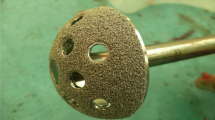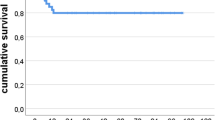Abstract
Purpose
The use of porous tantalum augments and titanium-coated cups in primary total hip arthroplasty (THA) with acetabular defects has shown satisfactory outcomes in our centre. The aim of this study was to report the long-term radiological and clinical outcomes of using this combination for Paprosky type III acetabular bone defects in acetabular revision.
Patients and methods
Between January 2007 and January 2015, 45 patients with Paprosky type III acetabular defects underwent acetabular revision using a combination of porous tantalum augments and titanium-coated cups. Among these, 41 patients (41 hips) had complete follow-up. Thirty-one patients had a Paprosky type IIIA defect, and ten patients had a Paprosky type IIIB defect. No patients had pelvic discontinuity. There were 20 males and 21 females with an average age of 63.2 years (range 35–80) at the time of revision surgery.
Results
The mean follow-up was 122.8 months (range 69–165). The Harris Hip Score (HHS) improved significantly from 32.1 points (range 17–58) pre-operatively to 85.3 points (63–98) at the last follow-up. The Short Form-12 (SF-12) and Hip Dysfunction and Osteoarthritis Outcome Score (HOOS) improved significantly for each item at the last follow-up. Two patients had a high hip centre post-operatively. One patient had recurrent dislocation but did not require re-revision. No further revision of the acetabular components was required, and all hips remained stable at the last follow-up with bony ingrowth of the acetabular components according to the criteria of Moore et al.
Conclusion
The combination of tantalum augments and conventional titanium-coated cups achieved satisfactory long-term radiographic and clinical outcomes for Paprosky type III acetabular bone defects without pelvic discontinuity.


Similar content being viewed by others
References
Paprosky WG, Perona PG, Lawrence JM (1994) Acetabular defect classification and surgical reconstruction in revision arthroplasty. A 6-year follow-up evaluation. J Arthroplasty 9:33–44
Sheth NP, Nelson CL, Springer BD et al (2013) Acetabular bone loss in revision total hip arthroplasty: evaluation and management. J Am Acad Orthop Surg 21:128–139
Bobyn JD, Poggie RA, Krygier JJ et al (2004) Clinical validation of a structural porous tantalum biomaterial for adult reconstruction. J Bone Joint Surg A 86-A(Suppl 2):123–9
O’Neill CJ, Creedon SB, Brennan SA et al (2018) Acetabular revision using trabecular metal augments for Paprosky type 3 defects. J Arthroplasty 33:823–828
Jenkins DR, Odland AN, Sierra RJ et al (2017) Minimum five-year outcomes with porous tantalum acetabular cup and augment construct in complex revision total hip arthroplasty. J Bone Joint Surg Am 99:e49
Flecher X, Appy B, Parratte S et al (2017) Use of porous tantalum components in Paprosky two and three acetabular revision. A minimum five-year follow-up of fifty one hips. Int Orthop 41:911–6
Whitehouse MR, Masri BA, Duncan CP et al (2015) Continued good results with modular trabecular metal augments for acetabular defects in hip arthroplasty at 7 to 11 years. Clin Orthop Relat Res 473:521–527
Löchel J, Janz V, Hipfl C et al (2017) Reconstruction of acetabular defects with porous tantalum shells and augments in revision total hip arthroplasty at ten-year follow-up. Bone Joint J 101-b:311–6
Mahmoud AN, Sundberg M, Flivik G (2017) Comparable results with porous metal augments in combination with either cemented or uncemented cups in revision hip arthroplasty: an analysis of one hundred forty-seven revisions at a mean of five years. J Arthroplasty 32:1612–1617
Borland WS, Bhattacharya R, Holland JP et al (2012) Use of porous trabecular metal augments with impaction bone grafting in management of acetabular bone loss. Acta Orthop 83:347–352
Gehrke T, Bangert Y, Schwantes B et al (2013) Acetabular revision in THA using tantalum augments combined with impaction bone grafting. Hip Int 23:359–365
Mäkinen TJ, Abolghasemian M, Watts E et al (2017) Management of massive acetabular bone defects in revision arthroplasty of the hip using a reconstruction cage and porous metal augment. Bone Joint J 99-b:607–13
Ling TX, Li JL, Zhou K et al (2018) The use of porous tantalum augments for the reconstruction of acetabular defect in primary total hip arthroplasty. J Arthroplasty 33:453–459
DeLee JG, Charnley J (1976) Radiological demarcation of cemented sockets in total hip replacement. Clin Orthop Relat Res 121:20–32
Callaghan JJ, Salvati EA, Pellicci PM et al (1985) Results of revision for mechanical failure after cemented total hip replacement, 1979 to 1982. A two to five-year follow-up. J Bone Joint Surg Am 67:1074–85
Abolghasemian M, Tangsataporn S, Sternheim A et al (2013) Combined trabecular metal acetabular shell and augment for acetabular revision with substantial bone loss: a mid-term review. Bone Joint J 95-b:166–72
Moore MS, McAuley JP, Young AM et al (2006) Radiographic signs of osseointegration in porous-coated acetabular components. Clin Orthop Relat Res 444:176–183
Harris WH (1969) Traumatic arthritis of the hip after dislocation and acetabular fractures: treatment by mold arthroplasty. An end-result study using a new method of result evaluation. J Bone Joint Surg Am 51:737–55
Klässbo M, Larsson E, Mannevik E (2003) Hip disability and osteoarthritis outcome score. An extension of the Western Ontario and McMaster Universities Osteoarthritis Index. Scand J Rheumatol 32:46–51
Ware JE, Kosinski M, Keller SD (1996) A 12-Item Short-Form Health Survey: construction of scales and preliminary tests of reliability and validity. Med Care 34:220–233
Blumenfeld TJ, Meehan JP (2014) The Use of Augment Devices in Revision Acetabular Surgery. JBJS Rev 2(3)
Flecher X, Appy B, Parratte S et al (2017) Use of porous tantalum components in Paprosky two and three acetabular revision A minimum five-year follow-up of fifty one hips. Int Orthop 41:911–6
Dwivedi C, Gokhale S, Khim HG et al (2017) Acetabular defect reconstruction with trabecular metal augments: study with minimum one-year follow-up. Hip Pelvis 29:168–175
Eachempati KK, Malhotra R, Pichai S et al (2018) Results of trabecular metal augments in Paprosky IIIA and IIIB defects: a multicentre study. Bone Joint J 100-b:903–8
Grappiolo G, Loppini M, Longo UG et al (2015) Trabecular metal augments for the management of Paprosky type III defects without pelvic discontinuity. J Arthroplasty 30:1024–1029
Del Gaizo DJ, Kancherla V, Sporer SM et al (2012) Tantalum augments for Paprosky IIIA defects remain stable at midterm followup. Clin Orthop Relat Res 470:395–401
Lingaraj K, Teo YH, Bergman N (2009) The management of severe acetabular bone defects in revision hip arthroplasty using modular porous metal components. J Bone Joint Surg Br 91:1555–1560
Flecher X, Sporer S, Paprosky W (2008) Management of severe bone loss in acetabular revision using a trabecular metal shell. J Arthroplasty 23:949–955
Weeden SH, Schmidt RH (2007) The use of tantalum porous metal implants for Paprosky 3A and 3B defects. J Arthroplasty 22:151–155
Issack PS (2013) Use of porous tantalum for acetabular reconstruction in revision hip arthroplasty. J Bone Joint Surg Am 95:1981–1987
Hooten JP Jr, Engh CA, Heekin RD et al (1996) Structural bulk allografts in acetabular reconstruction. Analysis of two grafts retrieved at post-mortem. J Bone Joint Surg Br 78:270–5
García-Rey E, Madero R, García-Cimbrelo E (2015) THA revisions using impaction allografting with mesh is durable for medial but not lateral acetabular defects. Clin Orthop Relat Res 473:3882–3891
Hooten JP Jr, Engh CA Jr, Engh CA (1994) Failure of structural acetabular allografts in cementless revision hip arthroplasty. J Bone Joint Surg Br 76:419–422
Bozic KJ, Freiberg AA, Harris WH (2004) The high hip center. Clin Orthop Relat Res 420:101–105
Karaismailoglu B, Erdogan F, Kaynak G (2019) High hip center reduces the dynamic hip range of motion and increases the hip load: a gait analysis study in hip arthroplasty patients with unilateral developmental dysplasia. J Arthroplasty 34:1267–72.e1
Emerson RH Jr, Head WC (1993) Dealing with the deficient acetabulum in revision hip arthroplasty: the importance of implant migration and use of the jumbo cup. Semin Arthroplasty 4:2–8
Abolghasemian M, Tangsaraporn S, Drexler M et al (2014) The challenge of pelvic discontinuity: cup-cage reconstruction does better than conventional cages in mid-term. Bone Joint J 96-b:195–200
Taunton MJ, Fehring TK, Edwards P et al (2012) Pelvic discontinuity treated with custom triflange component: a reliable option. Clin Orthop Relat Res 470:428–434
De Martino I, Strigelli V, Cacciola G et al (2019) Survivorship and clinical outcomes of custom triflange acetabular components in revision total hip arthroplasty: a systematic review. J Arthroplasty 34:2511–2518
Sporer SM, Bottros JJ, Hulst JB et al (2012) Acetabular distraction: an alternative for severe defects with chronic pelvic discontinuity? Clin Orthop Relat Res 470:3156–3163
Acknowledgements
We would like to thank the relevant staff for guidance and assistance, and for their support and collaboration in our hospital. We thank the patients in this study.
Funding
The study was funded by Key Research & Development program of Science & Technology Department of Sichuan Province (No. 2018SZ0255).
Author information
Authors and Affiliations
Contributions
Z-K. Z and F-X. P conceived and designed this study; QX and BX collected the data; QX, KZ, and M-C. Y performed the statistical analysis; QX wrote the manuscript; QX, BX, KZ, T-X. L, and Z-K. Z revised this manuscript. All authors reviewed the final manuscript. All authors agree to be accountable for all aspects of the work.
Corresponding author
Ethics declarations
Ethics approval
The study protocol was approved by the ethics committees of West China Hospital, Sichuan University.
Conflict of interest
The authors declare no competing interests.
Additional information
Publisher's note
Springer Nature remains neutral with regard to jurisdictional claims in published maps and institutional affiliations.
Rights and permissions
About this article
Cite this article
Xiao, Q., Xu, B., Zhou, K. et al. Long-term results of combined porous tantalum augments and titanium-coated cups for Paprosky type III bone defects in acetabular revision. International Orthopaedics (SICOT) 45, 1699–1706 (2021). https://doi.org/10.1007/s00264-021-05075-5
Received:
Accepted:
Published:
Issue Date:
DOI: https://doi.org/10.1007/s00264-021-05075-5




